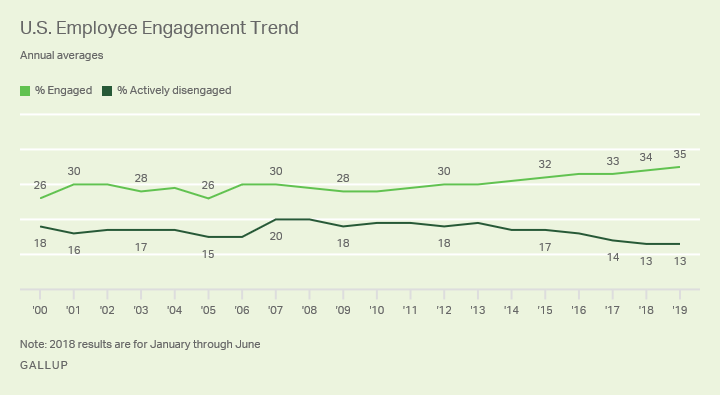Story Highlights
- Engagement levels reached a record high in 2019
- Teams with higher engagement are less likely to leave their organization
- High-development organizations have four themes in common
The decade opens with good news in the U.S. workplace.
Gallup found that in 2019, the percentage of "engaged" workers in the U.S. -- those who are highly involved in, enthusiastic about and committed to their work and workplace -- reached 35%. This is a new high since Gallup began tracking the metric in 2000.
The percentage of workers who are "actively disengaged" -- those who have miserable work experiences and spread their unhappiness to their colleagues -- tied its lowest level (13%), consistent with the 2018 finding. This makes the ratio of engaged to actively disengaged workers 2.7-to-1, the highest ever in Gallup tracking. These findings are based on a random sample of 4,700 full- and part-time U.S. employees working for an employer from January to August 2019.

The remaining 52% of workers are in the "not engaged" category -- those who are psychologically unattached to their work and company and who put time, but not energy or passion, into their work. Not engaged employees will usually show up to work and contribute the minimum required. They're also on the lookout for better employment opportunities and will quickly leave their company for a slightly better offer.
At the start of the trend in 2000, 26% of workers were engaged and 18% were actively disengaged. The nine-percentage-point increase in engagement and five-point decrease in active disengagement represents an improvement of approximately 12 million more engaged workers and 7 million fewer actively disengaged workers over the past two decades.
Engagement has accelerated the most over the past decade, with a seven-point improvement in the percentage of engaged workers and a five-point drop in actively disengaged. This represents approximately 10 million more people with engaging jobs over the past decade.
The Impact of High Engagement
Employee engagement is determined by factors such as feeling clear about your role, having the opportunity to do what you do best, having opportunities at work to develop, enjoying strong coworker relationships and working with a common mission or purpose.
Importantly, these are all factors that managers can directly influence and that vary considerably in how they are executed across teams within most organizations.
Gallup has completed nine meta-analyses of the relationship between team engagement and performance over the past two decades. The most recent study included more than 82,000 teams in 230 organizations -- and 1.8 million employees -- across 49 industries and in 73 different countries.
In short, team members with higher levels of engagement:
- produce substantially better outcomes
- treat customers better and attract new ones
- are more likely to remain with their organization than those who are less engaged
Engaged employees are also healthier and less likely to experience burnout.
What has led to improvements in engagement?
There are several possible explanations for the changes in engagement over the past decade, and Gallup has reviewed many of these previously, from changes in the economy to slight improvements in some employee benefits. But these factors are not the primary drivers of improved engagement.
Gallup research indicates that changes in employee engagement are best attributed to changes in how organizations develop employees.
Engagement has accelerated the most over the past decade, with a seven-point improvement in the percentage of engaged workers and a five-point drop in actively disengaged. This represents approximately 10 million more people with engaging jobs over the past decade.
Gallup has studied hundreds of organizations during the past two decades. Many of these organizations have improved substantially over time -- some going from less than 20% engagement to over 70%. These organizations have focused on creating high-development cultures, where people can see their impact on the organization and its customers through their work. They have opportunities to develop their strengths and purpose into a career. This is essential, since the top reason that employees change jobs is to pursue career growth opportunities.
Here are four themes we've identified in organizations with high-development cultures:
1. High-development cultures are CEO- and board-initiated.
- The organization has a well-defined purpose and brand -- why it exists and how it wants to be known. Everyone in the organization understands that employee engagement is a system for achieving unity of purpose and brand. Leaders explicitly connect engagement elements to their business issues. This means making engagement relevant to everyday work rather than an abstract concept.
- Top executives initiate the effort. They know that their attitudes, beliefs and behaviors have a powerful cascading effect on their organization's culture. Leaders of great workplaces don't just talk about what they want to see in the management ranks -- they live it.
- Leaders map out a course for improvement. They identify where the company is today and where they want it to be in the future.
2. High-development cultures educate managers on new ways of managing -- moving from a culture of "boss" to "coach."
- The best organizations have leaders who encourage their teams to solve problems at the local level rather than using top-down commands. They focus their training and development programs on building local managers' and teams' capability to solve issues on their own.
- Engagement, performance and training are all aligned. Training is strengths-based and grounded in the 12 elements of engagement. Managers learn how to identify the strengths of team members and how to use and build strengths to achieve better outcomes.
- Training is tailored to managers' capacity. Managers with high performance and high team engagement receive more advanced curricula than those with lower performance and lower team engagement.
3. High-development cultures practice companywide communication.
- The best organizations have exceptional CHROs who build systems that teach managers how to develop employees in line with their innate tendencies.
- These organizations have a designated "champions network" that communicates, collects best practices and answers questions.
- The ongoing collection of best-practice examples creates a vivid picture of what highly engaged teams look like.
4. High-development cultures hold managers accountable.
- The companies in our study with the highest engagement levels see employee recognition as a means to develop and stretch employees to new levels of success. Recognition of outstanding team leaders sends a strong message about what the company values.
- Tolerance of mediocrity does not exist in the best organizations. They define high team performance based on a combination of metrics such as productivity, retention rates, customer service and employee engagement. It is clear to those managers that their job is to engage their teams. The best companies have consequences for ongoing patterns of team disengagement -- most importantly, changing managers.
- The best organizations believe that not everyone should be a manager, and they create high-value career paths for individual contributor roles. No one should feel like their progress depends on being promoted to manager.
- The best organizations know there is no meaningful mission or purpose in the absence of clear expectations, ongoing conversations and accountability.
Gallup research indicates that changes in employee engagement are best attributed to changes in how organizations develop employees.
The percentage of engaged employees in the U.S. is still far too low. There is plenty of room for improvement.
But the trend over the past decade is encouraging. Organizations that have contributed to the overall improvement in U.S. workplaces illustrate that there is no reason to rest on the status quo.
What would the world of work look like if organizations could double the percentage of engaged workers? This isn't a pie-in-the-sky question -- all evidence suggests it is possible. Organizations have been successful, over recent decades, in maximizing process efficiency through Six Sigma and advances in technology and automation -- doubling engagement would mean U.S. organizations have matched process efficiency with people efficiency.
Help keep the numbers of engaged employees trending upward:
- Learn how to maximize employee potential with our perspective paper on employee engagement.
- Position your employees for success and build stronger, more engaged teams with CliftonStrengths.
- Check out our employee engagement solutions and offerings -- and consider a strategic partnership with Gallup.





